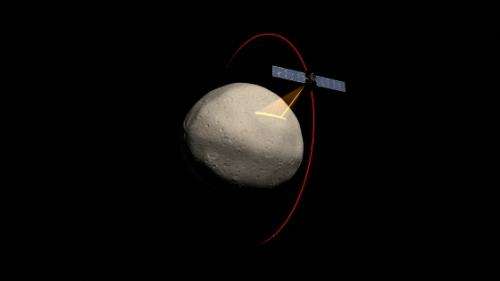Dawn spacecraft approaches protoplanet Vesta

(PhysOrg.com) -- NASA's Dawn mission to the doughnut-shaped asteroid belt between Mars and Jupiter, which launched in September 2007, is now approaching Vesta, a protoplanet that is currently some 143 million miles from Earth. Many surprises are likely awaiting the spacecraft.
"We often refer to Vesta as the smallest terrestrial planet," said Christopher T. Russell, a UCLA professor of geophysics and space physics and the mission's principal investigator. "It has planetary features and basically the same structure as Mercury, Venus, Earth and Mars. But because it is so small, it does not have enough gravity to retain an atmosphere, or at least not to retain an atmosphere for very long.
"There are many mysteries about Vesta," Russell said. "One of them is why Vesta is so bright. The Earth reflects a lot of sunlight — about 40 percent — because it has clouds and snow on the surface, while the moon reflects only about 10 percent of the light from the sun back. Vesta is more like the Earth. Why? What on its surface is causing all that sunlight to be reflected? We'll find out."
Dawn will map Vesta's surface, which Russell says may be similar to the moon's. He says he expects that the body's interior is layered, with a crust, a mantle and an iron core. He is eager to learn about this interior and how large the iron core is.
Named for the ancient Roman goddess of the hearth, Vesta has been bombarded by meteorites for 4.5 billion years.
"We expect to see a lot of craters," Russell said. "We know there is an enormous crater at the south pole that we can see with the Hubble Space Telescope. That crater, some 280 miles across, has released material into the asteroid belt. Small bits of Vesta are floating around and make their way all the way to the orbit of the Earth and fall in our atmosphere. About one in every 20 meteorites that falls on the surface of the Earth comes from Vesta. That has enabled us to learn a lot about Vesta before we even get there."
Dawn will arrive at Vesta in July. Beginning in September, the spacecraft will orbit Vesta some 400 miles from its surface. It will then move closer, to about 125 miles from the surface, starting in November. By January of 2012, Russell expects high-resolution images and other data about surface composition. Dawn is arriving ahead of schedule and is expected to orbit Vesta for a year.
"It's been a long trip," said Russell, who started planning the journey back in 1992. "Finally, the moment of truth is about to arrive."
Vesta, which orbits the sun every 3.6 terrestrial years, has an oval, pumpkin-like shape and an average diameter of approximately 330 miles. Studies of meteorites found on Earth that are believed to have come from Vesta suggest that Vesta formed from galactic dust during the solar system's first 3 million to 10 million years.
Dawn's cameras should be able to see individual lava flows and craters tens of feet across on Vesta's surface.
"We will scurry around when the data come in, trying to make maps of the surface and learning its exact shape and size," Russell said.
Dawn has a high-quality camera, along with a back-up; a visible and near-infrared spectrometer that will identify minerals on the surface; and a gamma ray and neutron spectrometer that will reveal the abundance of elements such as iron and hydrogen, possibly from water, in the soil. Dawn will also probe Vesta's gravity with radio signals.
The study of Vesta, however, is only half of Dawn's mission. The spacecraft will also conduct a detailed study of the structure and composition of the "dwarf planet" Ceres. Vesta and Ceres are the most massive objects in the main asteroid belt between Mars and Jupiter. Dawn's goals include determining the shape, size, composition, internal structure, and the tectonic and thermal evolution of both objects, and the mission is expected to reveal the conditions under which each of them formed.
Dawn, only the second scientific mission to be powered by an advanced NASA technology known as ion propulsion, is also the first NASA mission to orbit two major objects.
"Twice the bang for the buck on this mission," said Russell, who added that without ion propulsion, Dawn would have cost three times as much.
Unlike chemical rocket engines, ion engines accelerate their fuel nearly continuously, giving each ion a tremendous burst of speed. The fuel used by an ion engine is xenon, a gas that is also used in photo-flash units and which is more than four times heavier than air. Xenon ions shoot out the back of the engine at a speed of 90,000 miles per hour.
UCLA graduate and postdoctoral students work with Russell on the mission. Now is an excellent opportunity for graduate students to join the project and help analyze the data, said Russell, who teaches planetary science to UCLA undergraduates and solar and space physics to undergraduates and graduate students.
After orbiting Vesta, Dawn will leave for its three-year journey to Ceres, which could harbor substantial water or ice beneath its rock crust — and possibly life. On the way to Ceres, Dawn may visit another object. The spacecraft will rendezvous with Ceres and begin orbiting in 2015, conducting studies and observations for at least five months.
Russell believes that Ceres and Vesta, formed almost 4.6 billion years ago, have preserved their early record, which was frozen into their ancient surfaces.
"We're going back in time to the early solar system," he said.
Provided by University of California Los Angeles




















